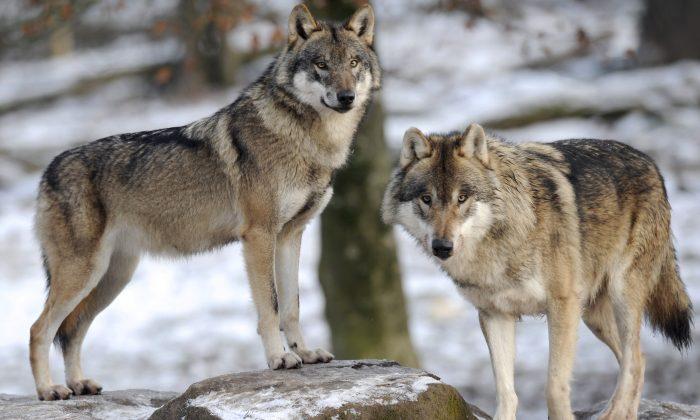House Republicans are urging the Biden administration to roll back protections for the grey wolf, citing the species’ growing population and conflicts with ranchers and farmers.
Congressman Cliff Bentz (R-Ore.) led 19 of his Republican colleagues in sending a letter to U.S. Fish and Wildlife Service (USFWS) Director Martha Williams on March 27 urging her to delist the grey wolf as a protected species under the Endangered Species Act (ESA).
“The service should move immediately to delist the grey wolf as a protected species which would allow the use of accepted methods of predator control to be used by ranchers and state agencies,” the letter says.
The letter follows the service’s decision last month to not re-list wolves in the Northern Rocky Mountains because it found the wolf was not in danger of extinction anywhere across the western United States.
Despite this finding, the service has done nothing to allow those bearing the burden of an apex predator’s reintroduction to protect themselves, livestock, or even deer and elk populations from the devastation caused by the predator, according to Mr. Bentz.
“The substantial growth in the population of grey wolves throughout Oregon and the western United States poses significant challenges for ranchers, farmers, and outdoorsmen alike,” said Mr. Bentz, who chairs the House Natural Resources Committee’s Water, Wildlife, and Fisheries Subcommittee.
Their impact on livestock herds is not, and cannot, be limited to just depredation, the letter added. “Wolves inflict much greater damage to herds than can be measured by simply counting carcasses.”
Wolves have an immense psychological impact on livestock herds that results in losses for producers, the letter explained.
“These losses can manifest as ‘stress, sickness, and reduced weight gain and pregnancy rates when wolves scare, chase or attack livestock.’
“Too often ranchers are put in the impossible situation of choosing between obeying the law and protecting their livelihoods.”
“The decision by the Fish and Wildlife Service to keep the grey wolf listed is disappointing and contrary to sound science,” added Congressional Western Caucus Chairman Dan Newhouse (R-Wash.) in a press release.
“It is clear that grey wolf populations have recovered and that state and local officials should be empowered to manage their grey wolf populations.”
The Numbers Out West
Grey wolves historically ranged across all of North America, including the western United States. However, decades of government-sponsored predator control programs brought the species to near extinction in the lower 48 states.By the time wolves were protected under the ESA of 1973, only a few hundred remained in northeastern Minnesota and Michigan, according to the U.S. Fish & Wildlife Service.
With these protections and aggressive programs to re-introduce the wolves to their historic range, their numbers have rebounded.
In 2023, the Oregon Department of Fish and Wildlife (ODFW) reported about 200 grey wolves in nearly 25 packs, though the agency acknowledges that number may be low.
Oregon state biologists also warned that the grey wolf population may have reached its ecological limit in the eastern third of the state and that packs would likely spread out to the west and south in greater numbers.
Meanwhile, ODFW investigated reports of 121 wolf depredations of dead or injured livestock in 2022, up from 90 investigations in 2021, according to the agency’s annual Wolf Report.
Statewide, confirmed depredations increased 55 percent from 2021 to 2022, according to the report.
Idaho’s grey wolf population was estimated at 1,337 wolves in 2022, 37 percent higher than the original recovery goal for the animals, according to Idaho’s Department of Fish and Game.
As of 2024, the California Department of Fish and Wildlife said there are six known packs of grey wolves in the state for a total of 45 adult wolves, juveniles, and pups.
In December 2023, Colorado Parks and Wildlife released 10 grey wolves obtained from Oregon onto public land.
Nine of those wolves were part of the large Five Points pack that had previously killed three livestock animals in Oregon.
Because of this predation, Oregon wildlife officials also permitted federal officials to kill four wolves from the Five Points pack in July and August.
Two wolves in Colorado killed or injured 20 domestic animals in two years, including 13 cows and a calf as well as four working dogs. Another wolf killed lambs.
Not Crying Wolf
“It’s about time we get delisting done,” said Union County Sheriff Cody Bowen.A lifelong resident of the small rural county in northeast Oregon, the sheriff feels distant bureaucrats do not understand the magnitude of the problems wolves cause his county.
“The wolves are out of control here,“ Sheriff Bowen told The Epoch Times. “One pack has at least 25 members and the females can birth three to five pups in a litter.“
He says the wolves not only prey on domestic sheep and cattle, but they are decimating local elk and deer herds and changing the natural behavior of wildlife.
“You rarely hear a bull elk bugle anymore, because they know they’re ringing the dinner bell for wolves when they do,” he said.
They also run the elk out of the hills and into farms and ranches where they wreck fencing and damage fields and crops, he explained.
Sheriff Bowen works hand-in-hand with local ODFW personnel to respond to predation, which can happen several times a month or as often as once a week, depending on the season.
The sheriff also described a face-to-face encounter with two wolves who tried to flank him while he rested against a tree in the forest.
“I heard the clacking of teeth on my left and turned, and there was a wolf just arm’s length away,” he said. As he pulled out his firearm he looked to his right, and another wolf was closing in.
“I emptied my pistol to run them off.”
In a neighboring county, a hunter was forced to kill a wolf that was stalking him even as a second wolf appeared nearby. Oregon State Police investigated the incident and found the hunter justified.
Sheriff Bowen believes delisting would open the doors to responsible management by conservationists.
“But even if that were to happen now, we will never be able to control the huge numbers of wolves. It’s already too late.”







